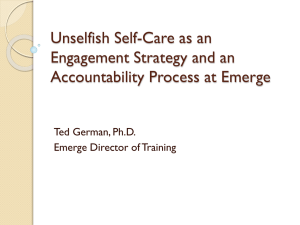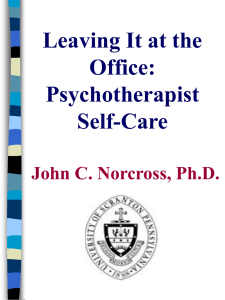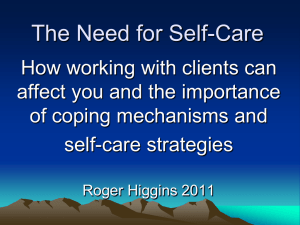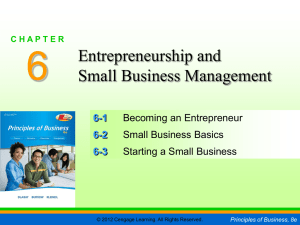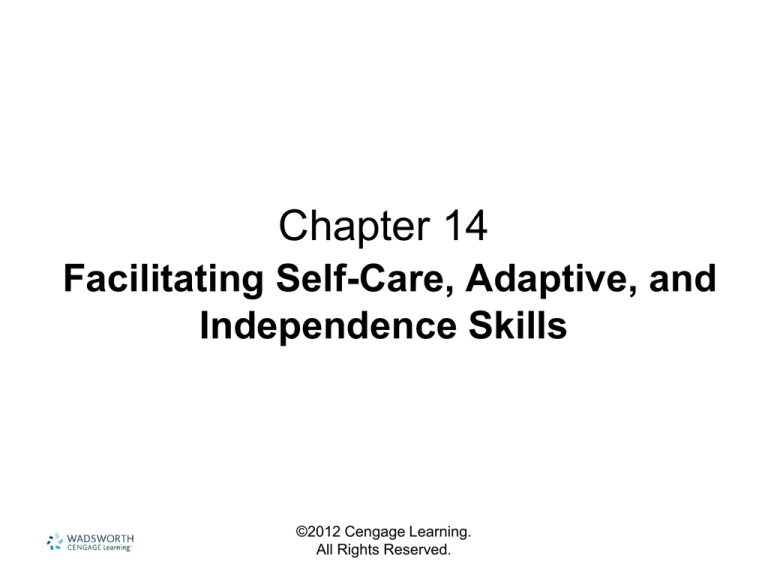
Chapter 14
Facilitating Self-Care, Adaptive, and
Independence Skills
©2012 Cengage Learning.
All Rights Reserved.
Definitions
• Functional skills—skills that, if a child
cannot perform, someone does for them.
• Adaptive behaviors are determined by
culture, but include eating, dressing,
toileting.
• Self-determination—people with
disabilities are taking an active role in
making choices about their own life.
©2012 Cengage Learning.
All Rights Reserved.
Self-Care Skills and the Curriculum
• Self-care skills are taught so that the
children can be as independent as
possible with or without their disability.
• Culture impacts the age that these skills
are taught.
• They should be taught throughout the day
when they are naturally occurring.
©2012 Cengage Learning.
All Rights Reserved.
Self-Care Skills and the Curriculum
(continued)
– Embedding self-care learning
• Self-care skills should be taught to generalize
skills.
• Self-care skills like eating can combine eating and
pre-academic skills like color words, vocabulary,
and number.
• Communication can take place encouraging a
child to share information during the teaching of
self-care skills.
©2012 Cengage Learning.
All Rights Reserved.
Self-Care Skills and the Curriculum
(continued)
– Individualizing self-care programs
• Building independence—allow children to
demonstrate their independence in skills and
practice, practice, practice.
• Building in success—celebrate the success of
doing a skill on their own, rejoice in the
accomplishment.
©2012 Cengage Learning.
All Rights Reserved.
Self-Care Skills and the Teacher
– Let the child do it
• As much as the children are able to do, let them
do.
• Encourage them to try, and reward the success.
– How much assistance?
• Teachers need to evaluate each child and learn
when to help, how to help, and how much to help.
• Avoid teaching learned helplessness because of
your lack of time and experience.
©2012 Cengage Learning.
All Rights Reserved.
Self-Care Skills and the Teacher
(continued)
– When to help
• Least intrusive assistance
– Offer help in unnoticeable ways so that the child feels
success.
• Excessive demands
– Watch for children who are seeking attention by
demanding adult help.
• When children can’t
– If a child is having an “off” day, offer support and
encouragement; if needed, a little assistance as well.
©2012 Cengage Learning.
All Rights Reserved.
Self-Care Skills and the Teacher
(continued)
– Game-like assistance
• Making learning fun is a way to keep a child
involved and interested.
• It is also more fun to play a game than complete
rote practice activities.
©2012 Cengage Learning.
All Rights Reserved.
Self-Care Skills and the Teacher
(continued)
– How to help
•
•
•
•
•
Demonstrate
Encourage
Assist
Practice
Reinforce
©2012 Cengage Learning.
All Rights Reserved.
Self-Care Skills and the Teacher
(continued)
– Five steps of a systematic approach to
teaching self-care skills
•
•
•
•
•
Specify a goal for learning
Break the skill into small steps
Use a systematic teaching approach
Use data to evaluate progress
Modify the teaching as necessary
©2012 Cengage Learning.
All Rights Reserved.
Self-Care Skills and the Teacher
(continued)
– Step-by-step planning
• Evaluate each child on a skill and plan the steps
needed to help the child be successful.
– Maturation and learning
• As children mature, their skills level should as well.
• Toilet training programs are available to ease the
traumatic events involved.
• Chaining is linking events together like you would
a chain to organize skills.
©2012 Cengage Learning.
All Rights Reserved.
Self-Care Skills and the Teacher
(continued)
– Monitoring progress and communication
• All parties working with the child need to know the
skill sequence and the accomplishments of each
child.
• As the child progresses, the skill chart is updated
showing that the child is now more independent
than before.
©2012 Cengage Learning.
All Rights Reserved.
• It is suggested that buttoning, zipping, and
lacing boards may not be appropriate for a
young child to learn those skills. Why?
©2012 Cengage Learning.
All Rights Reserved.
Self-Care Skills and the Teacher
(continued)
– Special considerations
• When demonstrating a skill, do so from the child’s
perspective.
• When zipping, stand behind the child.
• When learning to tie, put the shoe in front of them
the way their shoe looks on their foot.
• When learning to dress, try to avoid pretty shaped
buttons, tight fitting clothing, and tags in funny
places.
• Use clothes with elastic waists and items that are a
little large.
©2012 Cengage Learning.
All Rights Reserved.



